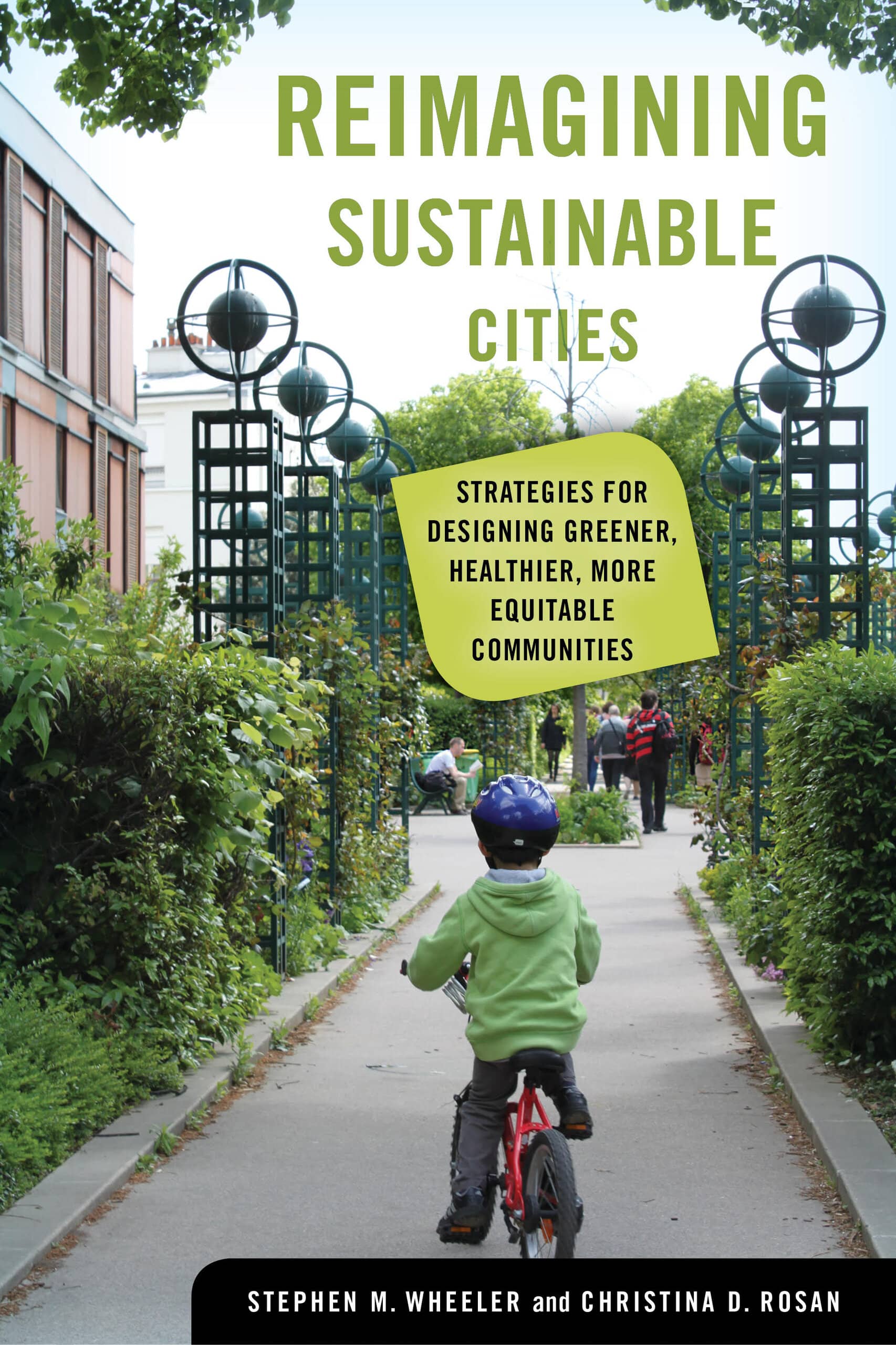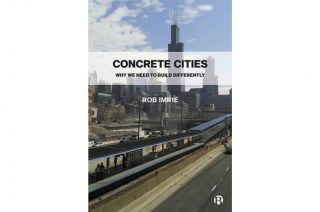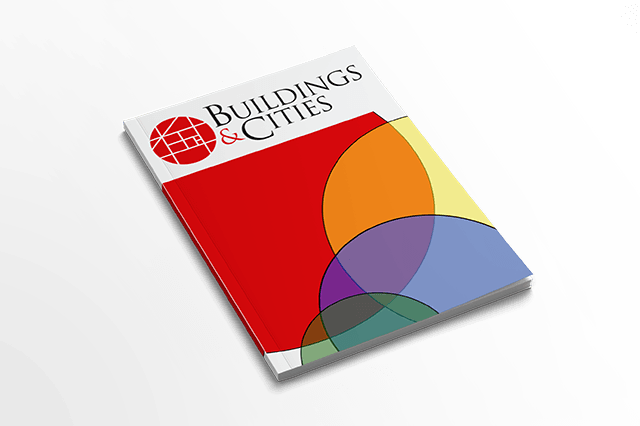
www.buildingsandcities.org/insights/reviews/reimagining-sustainable-cities.html
Reimaging Sustainable Cities: Strategies for Designing Green, Healthier, More Equitable Communities
By Stephen M Wheeler and Christina D Rosan. University of California Press, 2021, ISBN: 978052038121-6

Katherine Sugar reviews this book which higlights the need for proactive public sector leadership if we are to achieve sustainable cities.
This is an important and timely book that identifies creative public sector strategies for designing more sustainable and equitable communities, with a particular emphasis on addressing and ameliorating the impacts of climate change. In doing so, the authors reimagine current institutional, economic, political and social structures.
This interdisciplinary book is
primarily grounded in a 'social ecology' perspective which the authors define as
'the natural extension of holistic, systems-oriented thinking, integral to
ecological science and many of the world's wisdom traditions' (p.7-8). This
approach helps the reader to think more holistically across disciplines and
scales. The authors rightly argue that social equity principles have not been
focused on enough by decision makers. In turn, these ideas are prominent and
integrated throughout. For example, social inequality, racial injustice,
unaffordable housing and dysfunctional democracy all feature. With this, the
key argument is that sustainable transitions should be inclusive and equitable,
rather than exacerbate existing inequalities. The authors spotlight the
pandemic, as well as movements for racial and social justice such as Black
Lives Matter and climate change, as an important opportunity to reimagine
cities, rethink transportation needs and reconsider the ways to use urban space
to meet human needs.
The main themes of the book are distributed across twelve balanced chapters, and each is logically structured around explicit 'big-picture' questions regarding climate change. The reader is clearly taken along a journey from considering questions like: 'how do we get to climate neutrality?' (Chapter 1) and 'how can we make affordable, inclusive and equitable cities?' (Chapter 5) to 'how can each of us help lead the move towards sustainable communities' (Chapter 12). This narrative, which is developed primarily through a literature review, provides a cohesive structure which applies intersectional thinking across different disciplines to challenge business-as-usual debates. This is particularly distinguishable from other texts (which may focus on a particular discipline or sector) through addressing urban issues thematically, for instance, from an economic focus (Chapter 3) to geographical application (Chapter 5), to design and land management perspective (Chapters 7 and 8). On the whole, the chapters cover a wide scope of urban issues and strategies.
The book has a strong onus on public sector support to redistribute inequalities that arise from neoliberal ideologies, with robust arguments that a change in these profit-seeking and marginalising ideologies will help combat structural inequalities based on class, race and gender within societies, and which are further exacerbated by climate change. The authors argue the dominance of 'for-profit corporations and the wealthy [who] are allowed to run government' (p.270) will ultimately lead to a less sustainable and equitable society by valuing self-interest of elites above equality or sustainability.
Strategies for action are therefore focused on a more proactive public sector. The book concentrates on these forms for action at the urban level by city leaders and urban decision-makers. There is some attention given for changes at higher levels of government (for example, equalise funding and resources between cities), but generally, action is concentrated at the urban level, such as specifying strategies for effective democracy and local public engagement and taking sustainability leadership. As a result, bottom-up, citizen-led movements and top-down centralised actions are not discussed in detail (although are briefly touched upon). More could be stated therefore on the other actors operating within cities, such as the third and private sector, and the ways in which urban planners can work together with other cities to promote sustainable transitions.
The authors do strike a balance by discussing society-wide change and drawing upon multiple scales of action. They predominantly draw on cities in the Global North, for example in North America (such as Los Angeles and New York) and those in Europe (such as Paris, Barcelona and Copenhagen) to discuss sustainability initiatives integrated across the cities. The authors' attempt to use a global approach is somewhat unfulfilled through the application of only a handful of examples from the Global South. In addition, whilst there is a breadth of the issues covered in the book, some examples lack detail, and the reader is instead encouraged to consult the footnotes. In particular, the case studies are interwoven throughout the text but this is at the expense of depth. This lack of detail from the case studies is a somewhat missed opportunity, particularly for understanding how to operationalise the initiatives and examples used into different city contexts. For example, Paris is drawn upon as an example of a city strategy that has implemented policies to reduce vehicle use. While some detail is provided, there are remaining questions of the wider operationalisation of this, which stakeholders were engaged with, and how. As such, the book is therefore best placed for providing a general and broad overview, rather than specific examples with comprehensive detailing.
This book is an ideal companion to a wide range of readers wishing to think again about sustainable cities and stimulate change across urban areas. The narrative of positivity and optimism laid out in the context of achieving sustainability makes this book a refreshing and welcome addition to a mounting body of literature dedicated to sustainable urban action. The content provides useful background material to those who are beginning a journey in sustainable urban design or those seeking a practical and action-oriented standpoint, rather than a deeply theoretical perspective or for those who are seeking detailed information from a specific discipline. It is therefore suitable for a wide range of readers, such as students, practitioners, urban managers and policy makers, and citizens with a wider interest in climate change. The chapters are comprehensive in detail, yet very accessible and straight-forward to understand. This volume can be most appropriately used as an introduction and stepping stone to aid reader's further explorations. The issues in the book are neatly supported by table summaries, which set out pioneering strategies and opportunities for tackling climate change and social issues. This affords the reader with a selective way to navigate amongst the many issues and helpfully focus on a particular set of concerns.
Latest Peer-Reviewed Journal Content
A framework for 1.5°C-aligned GHG budgets in architecture
G Betti, I Spaar, D Bachmann, A Jerosch-Herold, E Kühner, R Yang, K Avhad & S Sinning
Net zero retrofit of the building stock [editorial]
D Godoy-Shimizu & P Steadman
Co-learning in living labs: nurturing civic agency and resilience
A Belfield
The importance of multi-roles and code-switching in living labs
H Noller & A Tarik
Researchers’ shifting roles in living labs for knowledge co-production
C-C Dobre & G Faldi
Increasing civic resilience in urban living labs: city authorities’ roles
E Alatalo, M Laine & M Kyrönviita
Co-curation as civic practice in community engagement
Z Li, M Sunikka-Blank, R Purohit & F Samuel
Preserving buildings: emission reductions from circular economy strategies in Austria
N Alaux, V Kulmer, J Vogel & A Passer
Urban living labs: relationality between institutions and local circularity
P Palo, M Adelfio, J Lundin & E Brandão
Living labs: epistemic modelling, temporariness and land value
J Clossick, T Khonsari & U Steven
Co-creating interventions to prevent mosquito-borne disease transmission in hospitals
O Sloan Wood, E Lupenza, D M Agnello, J B Knudsen, M Msellem, K L Schiøler & F Saleh
Circularity at the neighbourhood scale: co-creative living lab lessons
J Honsa, A Versele, T Van de Kerckhove & C Piccardo
Positive energy districts and energy communities: how living labs create value
E Malakhatka, O Shafqat, A Sandoff & L Thuvander
Built environment governance and professionalism: the end of laissez-faire (again)
S Foxell
Co-creating justice in housing energy transitions through energy living labs
D Ricci, C Leiwakabessy, S van Wieringen, P de Koning & T Konstantinou
HVAC characterisation of existing Canadian buildings for decarbonisation retrofit identification
J Adebisi & J J McArthur
Simulation and the building performance gap [editorial]
M Donn
Developing criteria for effective building-sector commitments in nationally determined contributions
P Graham, K McFarlane & M Taheri
Reimagining circularity: actions for optimising the use of existing buildings
R Lundgren, R Kyrö, S Toivonen & L Tähtinen
Effective interdisciplinary stakeholder engagement in net zero building design
S Vakeva-Baird, F Tahmasebi, JJ Williams & D Mumovic
Metrics for building component disassembly potential: a practical framework
H Järvelä, A Lehto, T Pirilä & M Kuittinen
The unfitness of dwellings: why spatial and conceptual boundaries matter
E Nisonen, D Milián Bernal & S Pelsmakers
Environmental variables and air quality: implications for planning and public health
H Itzhak-Ben-Shalom, T Saroglou, V Multanen, A Vanunu, A Karnieli, D Katoshevski, N Davidovitch & I A Meir
Exploring diverse drivers behind hybrid heating solutions
S Kilpeläinen, S Pelsmakers, R Castaño-Rosa & M-S Miettinen
Urban rooms and the expanded ecology of urban living labs
E Akbil & C Butterworth
Living with extreme heat: perceptions and experiences
L King & C Demski
A systemic decision-making model for energy retrofits
C Schünemann, M Dshemuchadse & S Scherbaum
Modelling site-specific outdoor temperature for buildings in urban environments
K Cebrat, J Narożny, M Baborska-Narożny & M Smektała
Understanding shading through home-use experience, measurement and modelling
M Baborska-Narożny, K Bandurski, & M Grudzińska
Building performance simulation for sensemaking in architectural pedagogy
M Bohm
Beyond the building: governance challenges in social housing retrofit
H Charles
Heat stress in social housing districts: tree cover–built form interaction
C Lopez-Ordoñez, E Garcia-Nevado, H Coch & M Morganti
An observational analysis of shade-related pedestrian activity
M Levenson, D Pearlmutter & O Aleksandrowicz
Learning to sail a building: a people-first approach to retrofit
B Bordass, R Pender, K Steele & A Graham
Market transformations: gas conversion as a blueprint for net zero retrofit
A Gillich
Resistance against zero-emission neighbourhood infrastructuring: key lessons from Norway
T Berker & R Woods
Megatrends and weak signals shaping future real estate
S Toivonen
A strategic niche management framework to scale deep energy retrofits
T H King & M Jemtrud
Generative AI: reconfiguring supervision and doctoral research
P Boyd & D Harding
Exploring interactions between shading and view using visual difference prediction
S Wasilewski & M Andersen
How urban green infrastructure contributes to carbon neutrality [briefing note]
R Hautamäki, L Kulmala, M Ariluoma & L Järvi
Implementing and operating net zero buildings in South Africa
R Terblanche, C May & J Steward
Quantifying inter-dwelling air exchanges during fan pressurisation tests
D Glew, F Thomas, D Miles-Shenton & J Parker
Western Asian and Northern African residential building stocks: archetype analysis
S Akin, A Eghbali, C Nwagwu & E Hertwich
Join Our Community

The most important part of any journal is our people – readers, authors, reviewers, editorial board members and editors. You are cordially invited to join our community by joining our mailing list. We send out occasional emails about the journal – calls for papers, special issues, events and more.
We will not share your email with third parties. Read more



Latest Commentaries
COP30 Report
Matti Kuittinen (Aalto University) reflects on his experience of attending the 2025 UN Conference of the Parties in Belém, Brazil. The roadmaps and commitments failed to deliver the objectives of the 2025 Paris Agreement. However, 2 countries - Japan and Senegal - announced they are creating roadmaps to decarbonise their buildings. An international group of government ministers put housing on the agenda - specifying the need for reduced carbon and energy use along with affordability, quality and climate resilience.
Building-Related Research: New Context, New Challenges
Raymond J. Cole (University of British Columbia) reflects on the key challenges raised in the 34 commissioned essays for Buildings & Cities 5th anniversary. Not only are key research issues identified, but the consequences of changing contexts for conducting research and tailoring its influence on society are highlighted as key areas of action.